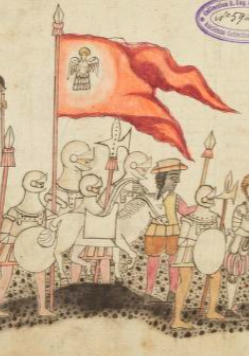caballo (Azca29)
This painted black-line drawing of the iconographic example of a horse comes from the scene of the invading Spanish group in 1519. The horse is shown in profile, facing right, and it is drawn by the tlacuilo with considerable detail. The hooves with horseshoes nailed on are an example of the detail. The saddle is rather simplified, but the halter receives somewhat more attention.
Stephanie Wood
Horses seem to have been woven fairly seamlessly into the Nahua repertoire of hieroglyphs, even if this example here is just part of a scene of the Spanish invasion. See below for examples of horse glyphs.
Marc Thouvenot has a vignette from the Códice Durán where Spaniards ride horses, which might be useful for comparing the kind of detail tlacuilos could show for horses: https://vignettes.sup-infor.com/imagen/2-DU_01_204_v_a.
Stephanie Wood
post-1550, possibly from the early seventeenth century.
Jeff Haskett-Wood
caballos, animales, entradas, expediciones
caballo, horse, https://nahuatl.wired-humanities.org/content/caballo
el caballo
Stephanie Wood
The Codex Azcatitlan is also known as the Histoire mexicaine, [Manuscrit] Mexicain 59–64. It is housed in the Bibliothèque Nationale de France, and hosted on line by the World Digital Library and the Library of Congress, which is “unaware of any copyright or other restrictions in the World Digital Library Collection.”
https://www.loc.gov/resource/gdcwdl.wdl_15280/?sp=29&st=image
The Library of Congress is “unaware of any copyright or other restrictions in the World Digital Library Collection.” But please cite Bibliothèque Nationale de France and this Visual Lexicon of Aztec Hieroglyphs.



